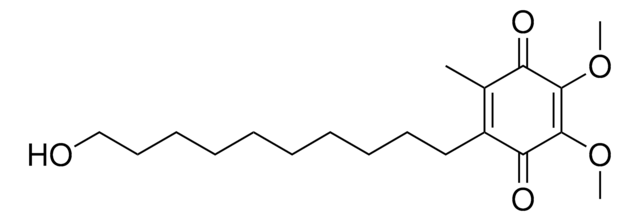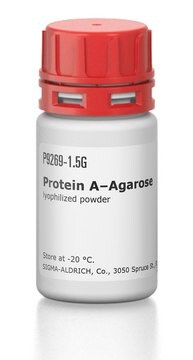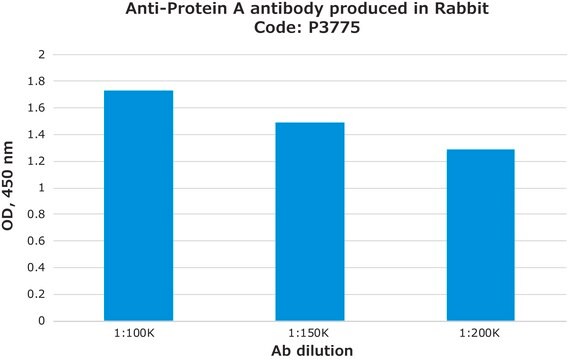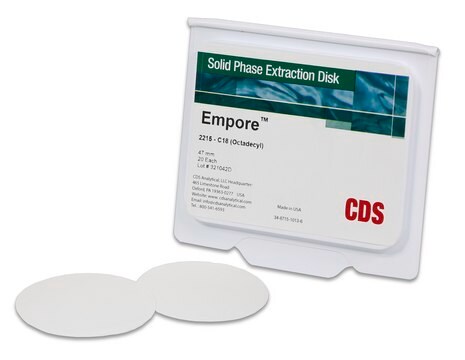82485
Protein A (extracellular) from Staphylococcus aureus
lyophilized, ≥90% protein basis
Sign Into View Organizational & Contract Pricing
All Photos(1)
About This Item
Recommended Products
conjugate
unconjugated
Assay
≥90% protein basis
form
fibers
quality
lyophilized
mol wt
Mr ~41000
species reactivity
pig, cat, monkey, guinea pig, rabbit, dog, mouse, human
technique(s)
ELISA: suitable
immunohistochemistry: suitable
immunoprecipitation (IP): suitable
western blot: suitable
UniProt accession no.
storage temp.
2-8°C
Gene Information
Staphylococcus aureus subsp. aureus NCTC 8325 ... SAOUHSC_00069(3919448)
Looking for similar products? Visit Product Comparison Guide
General description
Protein A is a highly stable cell surface receptor produced by several strains of Staphylococcus aureus. This protein is capable of binding to the Fc portion of immunoglobulins, especially IgGs, from a large number of species. One protein A molecule has been shown to bind at least 2 molecules of IgG simultaneously. The IgG binding domain of Protein A consists of three anti-parallel alpha-helicies, the third of which is disrupted when the protein is complexed with the Fc region of the immunoglobulins. Protein A will bind the Fc portion of human IgG subclasses, IgM, IgA and IgE; and mouse IgG1 (weakly), IgG2a, and IgG2b. Protein A also associates with IgGs from other species, including monkey, rabbit, pig, guinea pig, dog, and cat.
Protein A is involved in regulating anti-tumor, toxic, and carcinogenic functions. In addition to acting as an immunomodulator, it also has antifungal and antiparasitic properties.
Protein A is involved in regulating anti-tumor, toxic, and carcinogenic functions. In addition to acting as an immunomodulator, it also has antifungal and antiparasitic properties.
Application
Protein A may be conjugated with various reporter molecules such as fluorescent dyes (FITC), enzyme markers (peroxidase, beta-galactosidase, alkaline phosphatase), biotin, and colloidal gold without affecting the antibody binding site on the molecule. These conjugates may be used to detect immunoglobulins using immunochemical assays such as western blotting, immunohistochemistry, and ELISA. In addition, protein A may also be immobilized on a solid supports like agarose or acrylic beads for the purification of polyclonal or monoclonal immunoglobulins. It is also routinely used for immunoprecipitation assays. Furthermore, protein A has been used for affinity chromatography and SDS-PAGE assays.
Packaging
Bottomless glass bottle. Contents are inside inserted fused cone.
Other Notes
Protein A: nature′s universal anti-antibody - a review on properties and applications of protein A
Disclaimer
Unless otherwise stated in our catalog or other company documentation accompanying the product(s), our products are intended for research use only and are not to be used for any other purpose, which includes but is not limited to, unauthorized commercial uses, in vitro diagnostic uses, ex vivo or in vivo therapeutic uses or any type of consumption or application to humans or animals.
Storage Class Code
11 - Combustible Solids
WGK
WGK 3
Flash Point(F)
Not applicable
Flash Point(C)
Not applicable
Personal Protective Equipment
dust mask type N95 (US), Eyeshields, Gloves
Choose from one of the most recent versions:
Already Own This Product?
Find documentation for the products that you have recently purchased in the Document Library.
Customers Also Viewed
A. Surolia et al.
Trends in Biochemical Sciences, 7, 74-74 (1982)
J I Flock et al.
The EMBO journal, 6(8), 2351-2357 (1987-08-01)
The gene encoding the fibronectin-binding protein (FNBP) from Staphylococcus aureus strain 8325-4 was isolated from a gene bank in pBR322. The original clone, containing a 6.5-kb insert, gave a functional product present in the periplasm of Escherichia coli. Analysis of
R Lindmark et al.
Journal of immunological methods, 62(1), 1-13 (1983-08-12)
The use of protein A from S. aureus (SpA) as an anti-IgG reagent in immunological techniques has extended in recent years, together with knowledge about its interaction with immunoglobulins of different species. Current data with respect to the binding of
Romel Rosales Ramirez et al.
Journal of virology, 93(4) (2018-11-23)
Dengue virus (DENV) is a mosquito-borne virus of the family Flaviviridae The RNA viral genome encodes three structural and seven nonstructural proteins. Nonstructural protein 1 (NS1) is a multifunctional protein actively secreted in vertebrate and mosquito cells during infection. In
Our team of scientists has experience in all areas of research including Life Science, Material Science, Chemical Synthesis, Chromatography, Analytical and many others.
Contact Technical Service









